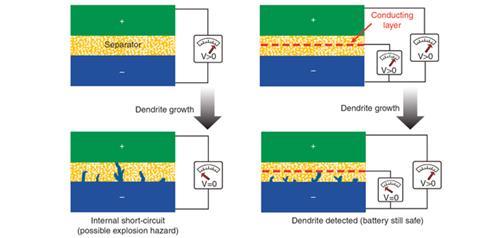Smart battery provides early warning to prevent overheating hazard
Lithium ion batteries are used in millions of electronic devices, such as laptops, smartphones and electric cars, but they are potentially hazardous. Under certain circumstances, they can catch fire – in 2013 an entire fleet of aircraft was grounded after their batteries overheated. Now researchers from the US and China have developed an early warning system to prevent such accidents.

Battery fires can happen when the electrodes come into direct contact and the system short circuits. The rapid build-up of heat during shorting can ignite the electrolyte, which contains a lithium salt (for example LiPF6) in a flammable organic solvent, such as dimethyl carbonate. A thin, porous polyethylene sheet usually prevents direct contact of the electrodes, but lithium dendrites – spongy structures that grow on the anode as the battery is used – can penetrate this barrier. Researchers still don’t fully understand the reasons for dendrite formation and attempts to prevent dendrites by modifying the electrode material or electrolyte have so far been unsuccessful. ‘As there is ever more demand for batteries with higher and higher capacities, a critical problem, which limits [batteries’] full potential, is safety,’ says Yi Cui from Stanford University, US
Cui and his team have now designed a smart battery with a separator that can detect these dangerous dendrites before they cause fire: a nanometre thin copper film sandwiched between two polyethylene sheets. If dendrites pierce the separator, they connect with the copper layer and a circuit connected to the copper sheet then shows a drop in voltage. This early warning leaves enough time to safely disconnect the battery. ‘It enables batteries in all applications to be used to their full lifetimes without concern of unexpected failure,’ Cui explains. The new separator doesn’t affect the battery’s performance as it has the same high electrical resistance, flexibility and porosity as standard models.
‘It’s a simple but innovative approach,’ commends material scientist Vasant Kumar from the University of Cambridge, UK. Electrochemist Cyril Marino from the Technical University Munich, Germany, agrees: ‘The separator solves a major safety issue of batteries currently on the market.’
Commercial use of Cui’s technology would increase production cost for batteries slightly. However, ‘in electric vehicles or personal devices, where fire or explosion would be truly catastrophic, this small increase in cost would more than offset the peace of mind and security gained by the consumer’, Cui counters.
Kumar points out that the problem of dendrites still remains and that ‘suppressing dendrites would be a more desirable goal in the long run’. But Cui hopes his work could also be a step towards solving this decades-old problem. ‘If we can find a way to determine when dendrites are forming, then we can also find a way to stop them,’ he predicts.












No comments yet